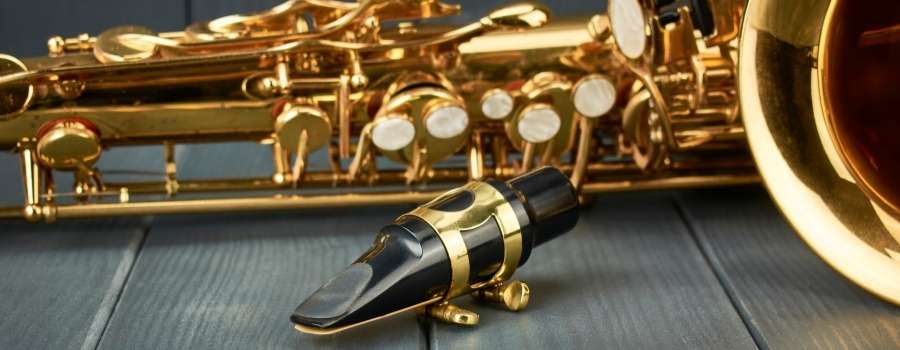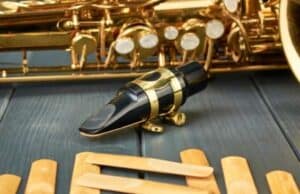
If you’re a new saxophone player you’ve likely done an inventory of everything that came with your new horn and what you found was most likely a shiny, black mouthpiece. And then, if you watched some famous jazz players on YouTube or have seen a jazz concert live you may have noticed the players were using gold or silver metal mouthpieces.
In general, saxophone mouthpieces are made of plastic, hard rubber, or metal. Each material, along with different facings and bores, will produce different timbres of sounds. Saxophone players will choose a material that will give them the sound they want for the style of music they are playing.
This may open up more questions than it answered, so let’s dive a little deeper into the three main materials used for producing saxophone mouthpieces:
- Plastic
- Hard Rubber
- Metal
Plastic
If you’re playing on a brand new saxophone or a rental saxophone, then you most likely have a plastic mouthpiece since this is what most often comes with “student” saxophones.
Plastic mouthpieces are cheaper to produce and are less expensive to purchase than hard rubber and metal mouthpieces. They are also more durable, making them ideal for smaller, less coordinated hands.
As you get a better handle on the instrument and start to refine your play style and tone, you may begin to dislike the brighter tone than plastic mouthpieces have. Harder reeds (the higher the number on the reed…like 3.5, 4, etc) will darken the tone a bit, but still not quite enough to compensate for the plastic mouthpiece. Plastic mouthpieces also don’t allow you to focus your sound as easily as hard rubber and metal.
Recommendations
As far as brands you might want to check out…really just stick to the one that came with your sax. At this early point in your saxophone career, you just want to focus on getting a good, in tune, even sound and learn your fingerings and music reading skills.
Hard Rubber
Hard rubber, or ebonite, is usually what you upgrade to in high school and use throughout your saxophone career. Of course, you’ll likely end up with a few different models with different-sized facings over the years…but you’ll likely have at least one hard rubber mouthpiece in your kit for the rest of your playing days.
Rubber mouthpieces are generally considered “classical” saxophone mouthpieces since they produce a darker, richer tone that blends well with large wind ensembles and orchestras. For these types of musical ensembles, the idea for everything to blend and create a homogenous sound.
However, many jazz saxophonists will also use hard rubber mouthpieces in addition to metal mouthpieces. Since you can get various bore sizes hard rubber mouthpieces can also project and stand out like metal mouthpieces so.
Recommendations
For someone who wants to have a darker, more “classical” sound then a mouthpiece made by Selmer Paris is worth checking out first.
Arguably the most popular of their mouthpieces are the Selmer C*, but I’m going to recommend the Selmer Paris Concept Mouthpiece mainly because the C* has a tendency to play a little flat due to its slightly longer design. The Concept series responds evenly and easily on the low and high ends.
Check out WoodwindBrasswind for current prices.
If jazz is more your thing, but you still want a slightly darker tone than a hard rubber mouthpiece provides, then Otto Link is a staple of jazz. With a 50 year pedigree, jazz musicians keep choosing the reliable sound of an Otto Link.
The Otto Link 6* is a great crossbreed mouthpiece for players wanting to switch between jazz and more “classical” performances. The only real negative is the ligature…some like it, some hate it. Think of a ligature as tires for a car. The stock tires are perfectly fine and will get you where you need to go…but sometimes you want tires that are a little better. So think of ligatures as just one of 4 parts to your saxophone setup: The sax, the mouthpiece, the ligature, and the reed.
Check out WoodwindBrasswind for current prices.
Metal

Metal mouthpieces are almost synonymous with jazz saxophone music. While many jazz players will play on hard rubber mouthpieces, you don’t see too many “classical” saxophonists playing on metal.
The main reason for this is that metal mouthpieces are going to have a bright sound that stands out. Metal is just more resonant than rubber and metal mouthpieces typically have a more open bore leading into the shank. This will allow more air to flow to get into the horn more quickly. Some people don’t like the brighter sound, but it definitely has its place. What you lose in focus you gain in brightness.
While you can still damage a metal mouthpiece…I mean, metal will bend, scratch, and dent…they are generally a lot more durable than other materials. So that’s a big plus. Another plus is that metal mouthpieces tend to be a little thinner than rubber so they tend to be a little narrower. This isn’t extremely noticeable for alto players, but if you end up playing tenor or bari the difference will be much more pronounced.
The main negative is the price point, which tends to be higher than hard rubber. Metals, in general, are higher in price per ounce than ebonite but where the price really goes up is due to the plating on the metal mouthpiece, which tends to be silver or gold.
Recommendations
Otto Link gets a mention here too…mainly because they were the first to introduce the world to metal mouthpieces back in the 1930s. You can’t go wrong with an Otto Link Metal 5, but I’m going to recommend the Yanagisawa Metal 5…mainly because of the diversity in styles people are boasting about.
Jazz is more than just one style of music, it’s dozens of styles that can be melded together to create even more style, so having a mouthpiece that can bounce from funk to R&B, to acid jazz is a solid choice.
You can grab a Yanagisawa Metal 5 at WoodwinBrasswind.
What Are Some Uncommon Types Of Sax Mouthpieces?
Plastic, hard rubber, and metal are by far the most common materials used to make mouthpieces. But you may come across other materials so I want you to be familiar with them. They may help you develop a sound that stands out among other saxophone players…it’s just one more way to make your sound unique.
New players shouldn’t just run out and buy these mouthpieces…unless you happen to find a screaming good deal, they are going to cost a pretty penny and maybe a little more difficult to play well. I wouldn’t even consider one until I’ve been playing for a while…like all through grade school and into college.
But, you may happen upon one of these in a second-hand shop for a good price:
- Glass
- Wood
- Platic
Glass
Glass…or Crystal mouthpieces are fairly uncommon. There was a time when Vandoren was making them (under the Pomarico name) but they don’t seem to be in production at the time of this writing.
Luckily, if you really want one, you can find them at online second-hand shops and some of the prices don’t seem too terrible…about the same as a mid-level hard rubber or metal mouthpiece.
I think the main reason they didn’t take off in popularity is that metal mouthpieces already do what glass mouthpieces were intended to do and they do it better. So, for sound, they are on slightly lesser footing than metal mouthpieces but fall down in the durability category.
A glass mouthpiece is going to scratch, chip, and break a whole lot easier than plastic, rubber, or metal. You can’t use standard ligatures (the ring that holds the reed to the mouthpiece) either since they are usually made of metal and will scratch and wear out the area in which they are seated.
And the final nail in the glass mouthpiece coffin. They look awesome and beautiful…until you start playing on them. Remember, playing the saxophone is a very…wet thing…The mouthpiece is going to fill up with fog and spit seconds after you start playing. If you’re one of those people that plays right after they eat…guess what’s going to be blatantly visible inside your mouthpiece.
Wood
I’ll admit, this was a new one for me. I’m sure I’ve heard of wooden mouthpieces before but they’re not something that my mind filled with information on when I started thinking about his article. So I did some research.
It turns out that, like glass mouthpieces, these aren’t too common either…but are a little more common or at least more accepted. I come to this conclusion because you can still buy a new wooden mouthpiece from music shops.
The models that I found were made from Grenadilla wood, which makes sense because this is the same type of wood that professional clarinets and oboes are made from.
What did surprise me was that people that have played them say that they have a very bright tone. I would have bet money that the tone would be as dark, if not darker, than the tone of a hard rubber mouthpiece. I’m not completely sure why their sound is so bright, except that it must have to do with the bore size and reed-to-face relationship.
For downsides, you need to make sure the protective layer on the beak (part your top teeth rest on) stays in good shape otherwise your teeth will chisel away at the surface like a beaver felling a tree. There is also the cost…one of these mouthpieces will set you back 2 to 3 times the money as a mid-price rubber or metal mouthpiece.
Still…I want one now!
Plastic
Wait…what?! Yeh, I know I just wrote a whole section on plastic mouthpieces being a common material, many used in student or beginner mouthpieces.

That was all true.
What I’m talking about here is a current trend in mouthpieces where they are made of ABS plastic. Now, there’s nothing wrong with ABS plastic mouthpieces and the ones that come with your saxophone are perfect to learn on.
Where I would hesitate a bit though is paying “professional” mouthpiece prices (one company is on par with Otto Link prices!!) for what is still a plastic mouthpiece. Companies will try to entice players by offering up multiple colors and styles, but make sure you try before you buy.
They may be perfectly adequate or even downright awesome mouthpieces perfect for your style (playing style…not aesthetic style) but professional plastic mouthpieces haven’t been vetted enough in my opinion.
Final Thoughts
I stand by what I said up above, if you’re just starting out your musical journey then stick to the plastic mouthpiece that your sax came with. It’s going to get you through the fundamentals of playing and learning music and save you the frustrations that can come with more specialized mouthpieces.
Also, I want to mention that even though I have recommendations for mouthpieces on this site I would strongly caution against buying a mouthpiece you haven’t been able to try out.
I’m not even sure if that’s possible right now with the current global situation (for readers in 2050 lookup Covid 19) so buying online or just via recommendation might be your only option. But if your local store is allowing people to physically try mouthpieces, then take your horn into your friendly local music store and try before you buy!

